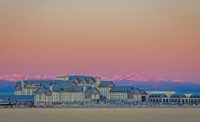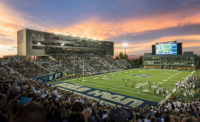Eye-popping resort construction is back in Vail, Colo. Demolition of the 1970s era Lionshead Inn in April 2014 kicked off the first major project in Colorado’s central mountains since before the recession.
Denver’s OZ Architecture had nearly finalized its design for The Lion (formerly called Strata) in 2006, but economic conditions at the time put the project on hold. The biggest project since the boom years of the last decade, the $90-million, 323,000-sq-ft, luxury condo complex is located across from the Concert Hall Plaza bus stop in Lionshead. It is tucked between a neighboring condo property, the village road and frontage road at West Lionshead Circle.
“It’s important because it signifies one of the first big projects to come out after the economic downturn, providing more [condo ownership] opportunities in Lionshead,” says Mike Harms, vice president and district manager for Denver’s PCL Construction Services Inc., the project’s general contractor. “It shows the owner’s confidence in the marketplace and the economy coming out of the recession.”
Favorable economic conditions and Vail’s tight condo market helped drive the demand. “We kept a close eye on the pulse of the construction economy and the real estate market as it began to pick up again,” says Rocky Cortina of Grupo Pegaso, the project’s owner.
“We saw a trend in the cost of construction as things began to pick up in Colorado and thought Denver’s flourishing economy would certainly translate into what we could accomplish in Vail,” he says.
Construction on the project will be complete at the end of this year, and sales of the 65 units began this summer as crews expedited completion of a model for buyers to preview.
Cortina says the project broke ground without a finance partner in place—and without any sales. “We understood what we were sitting on and had a very positive outlook. We wanted the market to come up a bit, and the previous concept of sales before construction was no longer achievable like it had been with the last wave of development in Vail.”
Alpine Modern
At the end of the last boom, the Arrabelle, Solaris and Four Seasons resorts had just been completed as major elements of Vail’s multibillion-dollar makeover. Each had a specific, thematic look—from Bavarian manor house to the new mountain-urban feel, explains Eduardo Illanes, an OZ principal and the project’s lead architect.
Illanes says OZ envisioned a reinvention of Vail while blending the Lion with the adjacent retail village. OZ calls it alpine modern, with a combination of stone, wood and high-end finishes.
Sound transmission at the Lion is “core efficient,” designed to isolate it from outside, cutting down on highway noise from nearby Interstate 70. “This creates another level of complexity but contributes to the livability,” Illanes says.
The building wraps around an anchored stone base, its design upgraded from the 2006 look, with a color palette defined by the granite that continues up the side of the building to accent timber and zinc elements.
When the project was revived in 2014, the project team also updated the exterior envelope to meet 2012 International Building Code changes that required more building efficiency, including additional insulation.
“All the details on the exterior were revised, and PCL worked with the design team to come up with a solution to make the exterior vapor barrier work,” says PCL’s Ryan Odell, the project manager. “The eight major finishes on the exterior— stone, wood, stucco, heavy timbers, glulam, siding, rain screen and metal wall panels—required many steps. The transition between those are complicated to draw, let alone build, making an already complicated exterior more complicated,” he says.
The first building in Vail to be designed under the 2012 building code (the town’s next-newest buildings comply with the 2003 code), the efficiencies in this building—heating, cooling, windows, fresh air and the envelope—should be realized in its operating budget, Cortina says.
Atypical Conditions
Driven by the need to maximize the footprint in relation to property lines, single-sided formwork was constructed for all below-grade foundation walls. Odell says the large, bulky system required tremendous coordination due to the lack of laydown area. The Lion’s tight footprint also meant there was limited space for deliveries and no place for the project’s nearly 300 workers to park.
“It was like building in a downtown area, with a lot of logistical planning required,” Odell says. PCL worked with its subcontractors to determine time slots for each day’s deliveries, applying lean construction principles and just-in-time delivery.
“Winter conditions are a different animal for mountain construction, and proper planning can make or break a schedule,” says Odell, who also managed construction of the Vail Ritz-Carlton. PCL put several temporary weather-protection and heat plans in place before starting the project. All of the concrete structure was placed during the winter and spring of 2014-15.
“It was challenging,” Odell says. “Kudos to our crews who self-performed the concrete structure, along with some key subs. They were out there every day in the snow, sometimes pouring concrete in blizzard conditions.”
Before excavation, crews installed a significant dewatering system to handle the high ground water at the site. Dewatering wells and pumps were placed around the building perimeter to move water from 80 ft down into stormwater drains. The process was monitored weekly until the permanent, under-slab dewatering system could be built.
During excavation, crews found a human skull and bones, and the jobsite was shut down during the investigation. Forensic experts determined that the remains were most likely those of a rancher from the late 1800s. Later, excavators also unearthed a boulder the size of two 40-yd dumpsters, requiring special equipment to remove it from 30 ft below ground.
Colorado’s construction labor shortages are compounded on mountain projects. “All the work going on in Denver keeps the workers down there. There’s no need for them to travel,” Odell says. PCL and its subcontractors had to come up with unique strategies to bring labor to the project, including per diems and affordable housing.
Although not a LEED project, “the overview is worth noting,” Cortina says. “It’s the first new building project to come on line in eight years, and we did our best to ensure this building is the greenest option out there while setting a benchmark for future projects in Vail.”
|







Post a comment to this article
Report Abusive Comment